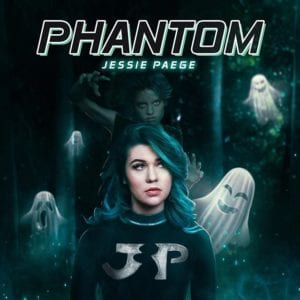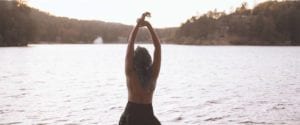Content warning: discussions of eating disorders, domestic violence, and sexual assault
Introduction:
Over the past three months, YouTuber Jessie Paege has turned up the volume on her activism-inspired music. Though her music career began with her organizing a women’s collaboration album, that was last year, and Paege has since stepped up to the microphone herself. She’s run the gamut of subjects in her discography: a bisexual anthem, a song about processing an abusive relationship, and a power ballad about fighting her eating disorder. Today I will be focusing on her second single and music video (mv), ‘Phantom’, analyzing it through a bisexual lens, treating it as a spiritual mirror to her original single, ‘Not a Phase’.
For context, Paege wrote ‘Phantom’, a pop rock song, with Lucy La Forge and Evan Blum. She had collaborated with Lucy La Forge earlier (who performs as Lucy & La Mer) on ‘Not a Phase’, which I will discuss later. Bailey Petracek directed the ‘Phantom’ mv, and it debuted on December 6th, 2019. They filmed at Wonderland in the Woods as part of the Create in Crestline estate. The song’s subject matter, like that of her other two singles, reflects her activism on the front of feminism, queer representation, body positivity, and physical-mental health. These themes dominate her main Instagram account; her bi pride is bright and unabashed. Her music is no less a statement. By filtering her video through bisexual colors, Jessie Paege recontextualizes its themes and creates a subtext about the intersections of biphobia, mental illness, and abuse.
Bisexuality as a Theory:
Before diving into analysis, I wanted to discuss why I am focusing specifically on a bisexual lens rather than going by general queer theory. Bisexual people face hostility from both sides of the aisle and partially because of this double-sided alienation, bisexual people have high rates in issues related to mental and physical health.
In a 1992 interview, bisexual activist David Lourea reflected on his activism in the 70s and 80s, describing how biphobia came from within the greater queer community:
We kept giving our lifeblood, our energy, to gay and lesbian liberation, yet we were still being discounted. I remember we were marching once with the gay community on Martin Luther King Day, and the gay papers listed every single organization that was part of the march, except for the Bi Center. That happened constantly. Alan Rockway, my wife Lee, Maggie Rubenstein, and I wrote letters to the editor of the B.A.R. [Bay Area Reporter, a San Francisco gay newspaper]. They would invalidate whatever we wrote by some stupid [headline] like “Bis feeling offended” or “… feeling left out.” There was a conspiracy of silence within the gay papers about our presence. (p. 51)
This “conspiracy of silence” resounds through political projects today. The 2017 docudrama miniseries When We Rise explores queer history as it pertains to the activism of the past half-century, yet the filmmakers failed to include the ‘B’ in LGBT and thus ignored bisexual contributions. An April 2018 report from the Global Philanthropy Project depressingly noted that, “Over the two-year period of 2015 and 2016, […] [p]rojects focused on serving the specific needs of Bisexual communities received only $2,000,” (p. 26). Last year, New York’s LGBT Community Center refunded a donation that had been given for bi-specific causes, returning the money to Sara Ramirez, a bisexual actress and activist.
Politics are a mirror to personal struggles, struggles that our stories and cultural touchstones reinforce. In her 2013 book, The B Word: Bisexuality in Contemporary Film and Television, Maria San Filippo coins ‘compulsory monosexuality’, a riff on the influential ‘compulsory heterosexuality’. She writes, “Homonormativity is […] complicit in compulsory monosexuality — the ideological and institutionalized privileging of either heterosexuality or homosexuality as the two options for mature sexuality that are socially recognized and perceived as personally sustainable,” (p. 12). So while queer theory and thus its theorists strive to reclaim history and art from the straight world, the more dominant monosexual voices of gay men and lesbians tend to overwrite potential bisexual representation. Those with a queer perspective can and do contribute to erasure. This includes ignoring the opposite-sex relationships of historical queer figures (p. 5), which ignores social context, because queer people did not distinguish between gay and bisexual people as we do today. Critical and academic analyses also erase bisexuality in fiction, characters defined by the gender of their current partner rather than defined by the entirety of their romantic histories. (Kori discussed this phenomenon last summer in her femslash podcast.)
Most sociopolitical and theoretical writings on bisexuality date back to the 90s. Similar to today, women dominated bisexual activism and culture, and this is partially rooted in the lesbian-bisexual split of the 70s and 80s (Udis-Kessler, p. 52-58). Up until a few decades ago, queerness centered around the sexual acts themselves rather than identity politics. For example, ‘lesbian’ has referred to any woman attracted to other women (Lesbian Health, p. 22). Spurned by radical feminism and lesbian separatism, bisexual women who had belonged to the lesbian feminist community for years found themselves alienated because of their feelings for men, so they started their own groups. As Clare Hemmings notes, in her 2002 book Bisexual Spaces: A Geography of Sexuality and Gender, bisexual theory comes from a place “to critically survey the current field of queer and feminist studies,” (p. 21). Yet it’s hard to find a concrete definition of this theoretical framework. Only Wikipedia offered up a definition specifically about bisexual theory, explaining (at the time of publication): “Bisexual theory is a field of critical theory, inspired by queer theory and bisexual politics, that foregrounds bisexuality as both a theoretical focus and as an epistemology.”
For me, bisexual theory uses the identity as a lens to address the rewriting of queer people (fictional or otherwise) as monosexual. Bisexual theory is also used for understanding how bisexuality intersects with gender and liminality in general, with bisexual media serving as a vehicle to express and articulate facets of the bisexual experience (as there is no one defining experience). This type of analysis has recurring themes of compulsory monosexuality, bi invisibility and erasure, and fluidity of expression.
Phantom’s Filter:
Collaborating with her film crew, Paege has incorporated bisexual colors into two of her videos and created a specific filter. This includes hair, costuming, lighting, and props. Based on Michael Page’s 1998 bisexual pride flag of pink, purple, and blue; the color scheme varies between the traditional dark shades and muted, pastel versions.
‘Not a Phase’ is explicitly about bisexuality, and its coloring is an extension of the lyrical content. Paege and La Mer sing about their desires for different people, and the singers act out a repressed attraction for one another, moments bordering on romantic and sexual interspersed throughout the video. Thus, the video ends as they finally kiss.
During the song’s bridge, Paege and La Mer lounge on a bed surrounded by flowers, bouquet ribbons, and balloons. These items come in softer shades of pink, purple, and blue; La Mer wears pink socks. Rainbows and a campy aesthetic are also scattered throughout the video. Its queerness, specifically its bi-ness, is not in question. These details matter because a similar color gradient — just in pastel — appears towards the beginning of ‘Phantom’, whose queerness is also indisputable as Paege depicts an explicitly queer couple.
In addition, Paege’s video plays with gender presentation and aesthetic, recalling the fluidity and androgyny that have defined bisexual culture for decades. Petracek and Paege employ a bisexual gaze to their collaboration: “a gaze that is neither masculine nor feminine and allows both object and viewer to experience and explore the fluidity of multiple genders and sexualities,” (Higa p. 75). While this gaze can be used in any medium of storytelling, it’s most apparent in film work, as the camera acknowledges the eroticism and beauty of all genders. Thor: Ragnarok is a recent mainstream example of this. The bisexual gaze does not objectify its characters because it does not single out one group of people as a static sight for consumption. One of its humanizing capabilities lies in this gaze’s focus on fluidity.
Queer Domestic Violence:
(Before going further, to be clear, I do not intend this analysis to be a statement on Paege’s personal life but rather an analysis of the version of herself that she presents in this video.)
‘Phantom’ opens with a brief clip of Paege and her love interest (played by Kay Coburn) gazing at each other with heart eyes. The hazy camera filter communicates a dreamlike quality within the relationship, as well as implying that this scene is far into the past. Such an implication works because the song details how a past lover haunts Paege as “a phantom in [her] head.” Abusive relationships often start out like a fairy tale as the perpetrator love bombs the target, the idyllic beginnings part of the seduction. Throughout this seven-second opener a ticking sound echoes, a time bomb about to go off.
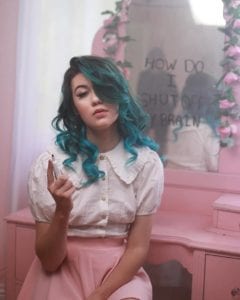 After transitioning with a cut to black, Paege appears singing to the camera, with a look that can best be described as femme horror. She wears a white, girlish blouse tucked into a baby pink skirt; her stiff, high collar and puffy sleeves recall the church-girl aesthetic in horror films. Think of the twins from The Shining and Esther Coleman from Orphan. She sits in front of a makeup table and vanity, singing, “Do you/Remember what I look like/Without tears in my eyes?/Without tears in my eyes?” The pink vanity matches her skirt, the glass framed by pink and blue roses. (Create in Crestline calls this room ‘Pink Dreams’, stressing its girlish fantasy.) This use of props and colors harkens back to ‘Not a Phase’. On the mirror, written in Sharpie, is the thought, “HOW DO I SHUT OFF MY BRAIN[.]” The lyrical references to sight fit with mirror as a metaphor for psychology. After another cut to black, Paege looks at the reflection, self-aware of her mental struggles. As she stares at her reflection, Coburn hugs her from behind and caresses Paege’s hair. While Coburn smiles, Paege sings, “Do you/Remember what it feels like/To never tell a lie?/Never tell a lie?”, alongside her pained and despondent reflection. The song’s pre-chorus mentions the couple’s “toxic chemistry” that affected Paege, and the video makes clear that the depicted relationship is a poison for her. Coburn’s affection even triggers Paege to take out the Sharpie, and in a parallel shot, the camera cuts to a quick clip of the lovers playing chess, Coburn grasping the edge of the board. They smirk as they move a piece while Paege stares in shock. From a metaphorical standpoint, the character has taken control of Paege’s mind, and back at the vanity, with Sharpie in hand, Paege adds a question mark to the message.
After transitioning with a cut to black, Paege appears singing to the camera, with a look that can best be described as femme horror. She wears a white, girlish blouse tucked into a baby pink skirt; her stiff, high collar and puffy sleeves recall the church-girl aesthetic in horror films. Think of the twins from The Shining and Esther Coleman from Orphan. She sits in front of a makeup table and vanity, singing, “Do you/Remember what I look like/Without tears in my eyes?/Without tears in my eyes?” The pink vanity matches her skirt, the glass framed by pink and blue roses. (Create in Crestline calls this room ‘Pink Dreams’, stressing its girlish fantasy.) This use of props and colors harkens back to ‘Not a Phase’. On the mirror, written in Sharpie, is the thought, “HOW DO I SHUT OFF MY BRAIN[.]” The lyrical references to sight fit with mirror as a metaphor for psychology. After another cut to black, Paege looks at the reflection, self-aware of her mental struggles. As she stares at her reflection, Coburn hugs her from behind and caresses Paege’s hair. While Coburn smiles, Paege sings, “Do you/Remember what it feels like/To never tell a lie?/Never tell a lie?”, alongside her pained and despondent reflection. The song’s pre-chorus mentions the couple’s “toxic chemistry” that affected Paege, and the video makes clear that the depicted relationship is a poison for her. Coburn’s affection even triggers Paege to take out the Sharpie, and in a parallel shot, the camera cuts to a quick clip of the lovers playing chess, Coburn grasping the edge of the board. They smirk as they move a piece while Paege stares in shock. From a metaphorical standpoint, the character has taken control of Paege’s mind, and back at the vanity, with Sharpie in hand, Paege adds a question mark to the message.
The scene ends as the music veers into the chorus, the camera following Coburn as they wrench Paege off the stool.
The day after the mv dropped, Paege posted five stills from the set on her Instagram, all taken at the vanity. These pictures function as a type of marketing for the video, advertising its themes, alluding to its aesthetic-based narrative. She starts holding the Sharpie in the second picture, which just so happens to be when Coburn appears, a shadowed figure reflected in the mirror. The character lurks in the background. In my opinion, the Sharpie as a totem for mental health is interconnected with Coburn’s character as an abusive love interest. Mental illness and toxic relationships feed one another: a person struggling with issues like anxiety and depression can be more vulnerable to exploitation, and then abuse can worsen symptoms and self-esteem. From a standpoint of sexual orientation, bi people have some of the worst rates in mental illnesses, including mood disorders and PTSD research demonstrates that much of this stems from biphobia, especially when the discrimination originates in the queer community. Bi people also have high rates of traumatization from domestic and sexual violence. A 2010 survey found that over sixty-one percent of bisexual women experienced, “rape, physical violence, and/or stalking by an intimate partner,” while almost half experienced, “severe physical violence,” (p. 2).
Queer domestic violence, especially as experienced by bisexual women, needs to be addressed in our politics and in our media. Paege explores this topic from a psychological standpoint, focusing on how interpersonal trauma affects her character’s interiority.
‘Phantom’ follows Paege and Coburn’s interactions through the verses, the audience seeing psychological abuse as it plays out in private. The second verse follows Coburn as they write across Paege’s upper body — words like “prude” and “anorexic” — that reflect and enhance Paege’s deepest insecurities and struggles. ‘Phantom’ lacks a lyric bridge, instead relying on intense instrumentation and backing vocals that repeat the title. When contemplating the Taylor Swift song ‘False God’, butthatsnotwhereminelives noted how it lacked a traditional bridge, relying on vocal riffs to express intense emotions, ones difficult to vocalize. The catharsis often found in music is stripped back to raw sound. ‘Phantom’ goes in the opposite direction emotionally: the audience watches a silent argument, Coburn antagonizing Paege to tears. As the music slides into a guitar solo, they start to passionately kiss, no resolution to the fight. It’s a relationship in extremes, and it leaves Paege bereft afterwards, hence her being haunted.
A Bisexual Lens on Gender:
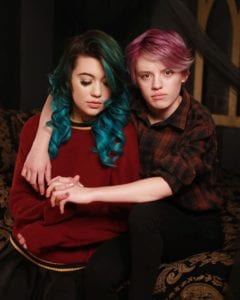 In regards to a bisexual gaze, the camera focuses on queer womanhood and non-binary expression. The aforementioned vanity scene has pastel variations of the bi flag: Paege’s hair and those blue flowers, the purple from Coburn’s hair, and then all that pink. (Over social media, Paege has described her hair as “blue”, the exact shade having likely diluted to a more greenish cast from washes.) Though the three colors never appear together again, the scene and thus its design set the tone of the relationship. In addition, the characters play with gender expression. Paege and Coburn dress with elements of the butch/femme dichotomy that belongs to all queer people, an aesthetic that originated with queer women’s culture. Coburn is non-binary, and their character’s look hugs the line between androgyny and butch. Their gender presentation switches to femme during the chess game, as they wear lingerie, reinforcing the fluidity of their self-expression. Androgyny is deeply rooted in bisexual culture (David Bowie, everyone), like all gender plays. For decades, the bi community has also used language to describe what we now understand as non-binary genders. Bisexual journal Anything That Moves released its first issue in 1990 with a manifesto that referenced this: “Bisexuality is a whole, fluid identity. Do not assume that bisexuality is binary or duogamous in nature: that we have “two” sides or that we must be involved simultaneously with both genders to be fulfilled human beings. In fact, don’t assume that there are only two genders.”
In regards to a bisexual gaze, the camera focuses on queer womanhood and non-binary expression. The aforementioned vanity scene has pastel variations of the bi flag: Paege’s hair and those blue flowers, the purple from Coburn’s hair, and then all that pink. (Over social media, Paege has described her hair as “blue”, the exact shade having likely diluted to a more greenish cast from washes.) Though the three colors never appear together again, the scene and thus its design set the tone of the relationship. In addition, the characters play with gender expression. Paege and Coburn dress with elements of the butch/femme dichotomy that belongs to all queer people, an aesthetic that originated with queer women’s culture. Coburn is non-binary, and their character’s look hugs the line between androgyny and butch. Their gender presentation switches to femme during the chess game, as they wear lingerie, reinforcing the fluidity of their self-expression. Androgyny is deeply rooted in bisexual culture (David Bowie, everyone), like all gender plays. For decades, the bi community has also used language to describe what we now understand as non-binary genders. Bisexual journal Anything That Moves released its first issue in 1990 with a manifesto that referenced this: “Bisexuality is a whole, fluid identity. Do not assume that bisexuality is binary or duogamous in nature: that we have “two” sides or that we must be involved simultaneously with both genders to be fulfilled human beings. In fact, don’t assume that there are only two genders.”
Petracek and cinematographer Chad Narducci never fetishize the characters. The camera focuses on Paege of course, her being the singer and thereby advertised artist, but it does not hypersexualize her. There are no lingering, dismembered shots across her body, the camera stays trained on her face. That being said, Paege does not divorce sexuality from her art. The chorus opens with, “Now you’re just a phantom in my head/An empty space inside my bed,” and her fluid dance movements and costumes reflect that. One of the sets is a bedroom, cast in purple tones to match her lingerie. As Paege sings the chorus, the video sharply cuts to rotating shots of her singing with a retro microphone. She wears various costumes that fall along the femme side of the femme-butch (futch) scale. Throughout this rotation, she sings the chorus with an intense energy, dancing and jumping around.
She too incorporates elements of gender-blending/androgyny. For example, Paege cosplays as Danny Phantom in the video. She wears a near-exact copy of his ghost form, having switched out his logo for her initials. Danny Phantom as a story is a great allegory for bisexuality and its isolation as he fits into neither world — that of the living and that of the dead. It’s a cute play on the song title, but it also hints at her subtext about bisexuality, and related to bisexuality is its amorphous qualities and invisibility, much like a ghost.
In addition, when she performs in the study, she wears a frilly dress and a top hat, a masculine clothing piece associated with power: the refined gentleman and the circus ringleader. In that setting, she also plays electric guitar aggressively, and as the guitar solo starts, she digs into it. She kneels on the floor, thrusting the guitar in an upwards arc, the neck almost phallic. Her choreography recalls, in my opinion, the posing associated with cock rock, an aggressive genre still in practice today. In his 1981 book, Sound Effects: Youth, Leisure, and the Politics of Rock ‘N’ Roll, Simon Frith describes cock-rock performers as posturers of male sexuality:
Their bodies are on display […], mikes and guitars are phallic symbols (or else caressed like female bodies), the music is loud, rhythmically insistent, built around techniques of arousal and release. […] What’s going on at such “hard rock” shows is a masturbatory celebration of penis power: girls are structurally excluded from this rock experience: it “speaks out” the boundaries of male sexuality. (p. 227)
By employing cock-rock elements with her body, Paege creates a feminine pop appropriation, using the music as a catharsis for her abuse and as a celebration of her sexuality.
Rock is known for being a masculine space, for gatekeeping and for ignoring important women in the field. This erasure includes the pioneering guitarist Sister Rosetta Tharpe; a queer, Black woman who The Daily Beast called “the Godmother of Rock ‘n’ Roll”. Paege even acknowledged this gender disparity in a humorous tweet last month: “more! girls! playing! electric! guitar!” From a bisexual standpoint, it’s her taking a masculine association and filtering it through another gendered expression, making it her own. Her chosen genre for ‘Phantom’, pop rock, is itself a hybridization of two very gendered art forms.
Themes of Control:
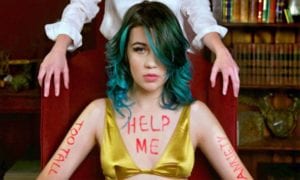
As mentioned earlier, Coburn’s character haunts Paege through psychological abuse. One instance includes the scene where they write over her body. The scene brings to life the second verse of ‘Phantom’: “You show me every insecurity/I’ve been trying to hide/Don’t know what it’s like/Like for me/Growing up shy.” She wears a gold bikini top, hyper exposed: “too tall”, “anorexic”, and “prude” in red across her arms and torso. And it should be noted that in the fight scene, the last clip with the couple, Paege wears another outfit: a baggy sweater that hides her body, her arms covered up compared to her previous white femme blouse and bikini top. The video’s thumbnail also presents a variation of the writing clip as Paege’s love interest lurks behind her, again androgynous in their presentation. From the picture, viewers can see “Too Tall” still written on her right arm, but “Help Me” above her sternum (replacing “anorexic”) and “Anxiety” on her left arm. References to her appearance reflect an unhealthy relationship to her body, while the “Help Me” gets at the heart of mental illness and abusive dynamics. In the context of her relationship, these statements of self-perception and self-understanding are related to her depicted bisexuality.
The chorus in ‘Phantom’ includes the lines, “Now you’re just a phantom in my head/And echo all the words you said.” Those words include, within the circumstances of the video, her body tags. Overall, the writings on Paege’s body embody themes of control that sharpen in the context of queer domestic violence. Her body, and thus its scars, becomes a testament to symptoms of biphobia and interpersonal trauma, especially when the two intersect.
Bisexual people have high rates of anxiety, and a coping mechanism for anxiety is trying to control as much of one’s environment as possible (speaking from experience). This includes overplanning an outing, making lists, and detesting surprises. Similarly, eating disorders are often connected to a need for control, using the body as a punching bag for frustration and to emotionally regulate. Taylor Swift described this compulsion when alluding to her eating disorder: “And I need to not, like, use my body as an exercise of control when I feel out of control in my life,” (t. 2:15-2:20). When examining this issue through a bisexual feminist lens, I gained a better understanding on how biphobia impacts bisexual women and their relationship with themselves.
In a 2006 study that compared straight women, bisexual women, and lesbians, the authors noted that eating disorders had a distinct connection to bisexuality:
An eating disorder history also demonstrated a relationship to being out. Out bisexuals were more likely to have an eating disorder than heterosexual women. It is unclear why this association would be found. Regardless of degree of outness, bisexual women were twice as likely to have had an eating disorder than lesbians. (p. 50-51)
That statistic about bisexual women’s rate for eating disorders, when compared to lesbians, was the same in 2014. Similarly, bisexual women had higher rates related to substance abuse, such as alcoholism and smoking.
I think that bisexuality and eating disorders are so intertwined partially because of society’s messages about bi people: They’re greedy, out of control, insatiable. Othered individuals who will do whatever it takes to feed their urges. A Buzzfeed writer reflected on the sociopathic bisexual trope, noting the characters’ relationship to eating. Her three character examples each had a particular craving. Kvartir, a queer Slovenian organization, contemplated two developing tropes, the Magical Bisexual and the Hedonist Bisexual. Though the writer acknowledges that the characters are usually heroes, their sexuality still isolates them: “[T]heir bisexuality is shown as another aspect of their otherness. Bisexuality is used as a metaphor to convey their hedonism, their alienness, or a general anarchistic attitude towards the rules of polite society.” Such depictions make it harder for bisexual people to see themselves in media as normal, complex individuals. All together, bisexual people internalize these negative messages about their sexuality and may subconsciously manage the biphobia by overexerting control over their bodies. This may ring especially true for women as these issues are heightened by other messages about womanhood and restraint. (I can’t say how this issue intersects with other kinds of marginalization like race.)
De Elizabeth, contributing editor to Teen Vogue, tweeted, “To live quietly with an eating disorder can feel a whole lot like disappearing inside yourself.” Another type of invisibility that can affect bisexual women. In ‘Phantom’, the writing acts as a visual manifestation of this illness and how it subsumes the self, the skin overtaken by obsessive, disparaging examinations: “anorexic” a condemnation. Along with her eating disorder, her related issues to self-perception are all exacerbated by an abusive relationship.
For bisexual women, their histories with interpersonal and sexual violence affect their relationships toward their bodies. Their agency is stripped from them, often by the people they trust the most. The media presents bi women as hypersexual, and in our rape culture, that contributes to the idea that bisexual women are always willing. Jealous lovers have been known to use the cheating bisexual trope against their partners. YouTuber Stevie Boebie summarized it well: “Bisexual women are not more accepted than gay men and lesbians, they’re more sexualized. And that is — there is a huge difference,” (t. 1:23-1:28). When it comes to ‘Phantom’ and sexuality, Coburn brands Paege as a “prude”, which could be interpreted as the intersection between misogyny and biphobia (i.e. stereotypes about the promiscuous bisexual). It’s the prude/slut dichotomy, and it’s shaming Paege for deviating from her assigned role as a sexual object.
In 1999, Sarah Sulis wrote “Battered Bisexual Women” for an anthology on queer domestic violence (p. 173-180). Though she only uses the term “battered”, which refers to physical abuse, her commentary can apply towards non-physical abuse as Sulis describes various forms of psychological abuse:
Bisexual women battered by other women report that they are called sexually degrading names and continually threatened about their bisexuality. In the same way that homophobia is used by batterers in heterosexual relationships, biphobia is used against bisexual and even lesbian women. […] The bisexual victim may constantly be accused of having affairs with both men and women. Verbal abuse may include comments such as “I’m the only one who will have you” and “If people knew about you, they would take my side.” For some bisexual women these tactics are particularly devastating because internalized shame may include shame about relationships with both men and women. (p. 175-176)
It’s not unreasonable to assume that those “sexually degrading names” can include “prude”. A perpetrator grows frustrated at a bisexual target asserting her boundaries, thus shaming her with an age-old term that describes a woman too in control. All because an abusive person aims to control every aspect of their target’s life. Even the act of someone writing on Paege’s body represents the objectification of bisexual women. It’s no coincidence that after using a black Sharpie to write the message on the mirror, the video switches to a red one for writing on Paege. It’s scarlet letters to denigrate a woman for her identity — her struggles and her agency — harmful social messages pressed into the psyche of her character.
Conclusion:
Stephen Daw, a staff writer for Billboard, covers queer topics in Hollywood. He reviewed ‘Phantom’ after it came out, and his thoughts reveal, to me, a troubling trend in media analysis. I’ve noticed that people tend to overlook depictions of domestic violence, ignoring blatant descriptions of psychological abuse. Daw writes:
Upon first listen, the song’s lyrics seem to point directly to a relationship that’s ended, as Paege belts about someone who was once there for her that has now vanished into thin air. […] What was once a song about a breakup quickly becomes an anthem for self-care and anxiety [in the video], as Paege sings not to an ex-lover, but to her own personal anxiety. […] It helps, though, that her anxiety has a face, as it’s given human form by actress Kay Coburn. Throughout the video, Paege’s purple-haired personification follows her around[.]
Did we watch separate videos? Nothing about the song — lyrically or visually — implied that the character felt supported by her partner. While art is open to interpretation, Daw’s thoughts on Coburn’s appearance reads as erasure. His description about Coburn being a personification of anxiety is absurd, as if the make-out clip never occurred.
This also bothers me because the queer community has a history of downplaying and silencing abuse amongst its own in order to not “look bad”. The straight world created a culture of compulsion and invisibility, and those with more social acceptance among queer people take up the same reins.
Carmen Maria Machado, a writer renowned for her queer speculative fiction, has had the Internet buzzing for the past few months. Her new memoir In the Dream House reflects on her past trauma from an abusive lesbian relationship; she divides the book into chapters based on different genres, which include the haunted house trope. In an interview, Machado reflected on the creation of her memoir within queer history: “I wrote this book because I was looking for something that didn’t exist[.] […] When that happens and you write towards something that’s untapped or doesn’t have art dedicated to it, it creates this new way for people to respond.”
Much like Machado, Paege uses her art to regain control of her narrative, creating a space to discuss queer domestic violence. Her music and subsequent videos function as vehicles to highlight subjects we tend to hide: queerness, abuse, eating disorders. She’s cleaning out the various rooms in her haunted house for the sake of her audience. She ends her ‘Phantom’ video with a pointed conclusion. After the song finishes, Paege is suddenly outside on the shores of a lake. She looks into the camera with a forlorn expression and kneels in the sand, washing the words off her literal skin. The filmmakers devoted the last thirty seconds of a four-minute video to this segment, the scene solemn as it’s the first and only scene to feature natural sounds. It’s a reflective moment when her thoughts fade away and she is engaged to her surroundings, participating in the ancient ritual of rebirth through cleansing.
Last week, Paege posted about filming two music videos. With her attention to detail and her commitment to social issues, I look forward to whatever collaboration that she and her film team put out next.


